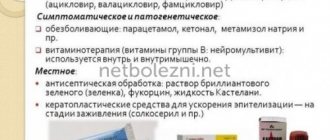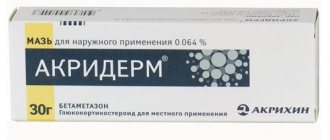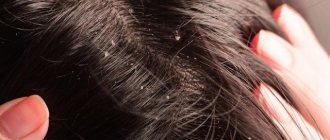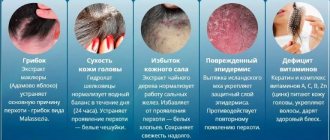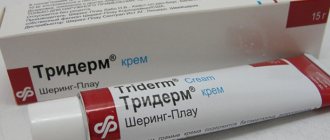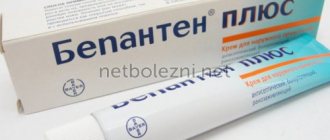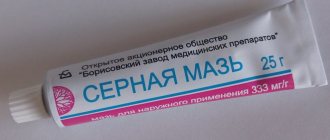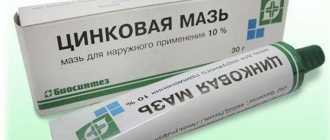Sulfur has long been used as one of the most effective remedies for treating acne. It is part of such cosmetics as soaps, creams, ointments, lotions and balms. This substance treats well such types of diseases as:
Scabies; Acne; Various types of dermatitis; Teenage acne, etc.
In addition to the main active ingredient, sulfur ointment contains cosmetic petroleum jelly and water. The moment the ointment hits the skin, sulfur reacts with the organic substances of the skin. As a result, compounds are formed in the form of sulfur sulfides, which have a healing effect for skin diseases.
This drug is suitable for any skin type and has no serious side effects.
Does sulfur ointment help with acne?
Acne is one of the main indications for using the ointment, indicated in the instructions for use. Dermatologists prescribe a drug with sulfur to treat small pimples localized to one area of the face. But most often, external therapy is practiced when diagnosing severe forms of acne. They are characterized by damage to all layers of the epidermis:
- the skin swells and turns red;
- the relief of the dermis becomes uneven, pits and tubercles appear;
- large pimples filled with purulent contents form;
- skin pores become wide, deep, residues of cosmetics and street dust accumulate in them;
- Subcutaneous pimples, dark spots, and comedones form.
The causes of acne are various internal and external unfavorable factors. These are sharp fluctuations in hormonal levels, endocrine and gastrointestinal diseases. Acne often signals errors in the diet. Problem skin often occurs in people who prefer fatty and sweet foods and fast food. Sulfur ointment for acne on the body and face can be used regardless of the cause of their formation. But, if after the acne disappears, it appears a few days later, you should consult a dermatologist. A thorough examination will help identify the acne trigger and eliminate it.
Benefits of sulfur
Sulfur is a trace element that enters the human body along with food. People who are actively involved in sports, vegetarians, and dieters can suffer from its deficiency. A lack of sulfur in the body is indicated by frequent relapses of chronic or infectious diseases.
People with a microelement deficiency have poor skin, dull hair that falls out profusely, and peeling nail plates.
Sulfur ointment is used for demodicosis (tick-borne infestation), scabies, acne and its consequences. Its active ingredient has a diverse positive effect on processes occurring in the dermis:
- eliminates pustular rashes;
- improves blood circulation, saturating the skin with oxygen, nutritional and bioactive compounds;
- regulates the functioning of the sebaceous glands;
- destroys pathogenic microorganisms - bacteria and fungi;
- prevents secondary infection of tissues.
Sulfur ointment effectively acts on blackheads, extracting their contents out and at the same time drying out the pores. The trace element also has a slight analgesic effect. After applying the drug to acne-affected areas of the skin, pain and itching disappear.
Description of the drug
Sulfur ointment is actively used in cosmetology to improve the condition of facial skin. It not only clears acne, but also becomes firmer and more elastic. Sulfur has powerful healing properties. Indications for the use of ointment include the following pathologies:
- acne on the skin of various etiologies;
- demodicosis is a disease caused by the parasitism of opportunistic mites (acne worms);
- psoriasis, characterized by the formation of painful papules and plaques on the skin;
- seborrheic lesions of the dermis due to malfunction of the sebaceous glands;
- mycoses - pathologies of fungal origin;
- lichens, the appearance of which was provoked by activated pathogenic fungi and viruses.
The use of the drug helps soften and loosen the upper layer of the epidermis. The scales begin to peel off intensively, and young healthy tissues form in their place. It is thanks to this ability that Sulfur Ointment is used to eliminate the effects of acne - scars and scars.
Pharmacological action and group
Sulfur ointment is a representative of the clinical and pharmacological group of antiseptics and disinfectants. It is prescribed regardless of the location of acne - on the chin, cheeks, wings of the nose. Acne can be treated externally for the following reasons:
- sulfur quickly stops inflammatory processes and prevents the formation of new rashes;
- under the influence of the ointment, blood circulation and microcirculation improves;
- the exfoliating effect of the drug helps eliminate red and blue spots;
- sulfur effectively fights swelling, removes purulent exudate from the pores;
- The microelement reduces the production of sebaceous secretions by the glands - the main cause of oily skin.
Sulfur ointment is used to treat acne and comedones complicated by bacterial and (or) fungal infection.
The drug has a pronounced antiparasitic, antimycotic and antibacterial effect.
Upon contact with organic compounds of the epidermis, sulfur is converted into sulfides and propionic acids. These substances are capable of inhibiting pathogenic microorganisms and destroying subcutaneous mites.
Composition and release form
Sulfur ointment is a thick, rich yellow, oily consistency with a specific odor. Domestic manufacturers package the drug in 25 and 30 g quantities in aluminum tubes and glass bottles. In pharmacies you can buy 8%, 10% and 33% medicine with sulfur to eliminate acne. The ointment contains the following auxiliary ingredients:
- purified water;
- medical Vaseline;
- emulsifier.
But the drug also comes with a different composition. Instead of Vaseline, manufacturers form an ointment base from mineral oils and paraffin. The addition of an emulsifier ensures better absorption of sulfur into inflammatory tissues. If you simply mix the trace element with Vaseline, most of it will remain on the surface of the skin. The introduction of an emulsifier into the composition promotes optimal contact of sulfur with organic compounds of the epidermis.
Sulfur ointment for acne - how to use
According to the instructions for use, sulfur ointment for acne is used 2 to 3 times a day. Dermatologists recommend applying it at night to prolong and enhance the therapeutic effect. The skin is first cleaned of decorative cosmetics and other contaminants. It is advisable to treat it with antiseptic solutions - Miramistin, Chlorhexidine, Furacilin. For this purpose, infusions of chamomile, string, calendula, and any tonics without alcohol are also used. To ensure successful treatment, adhere to the following medical recommendations:
- apply a thin layer of product to small rashes, and a thick layer to large acne;
- leave the drug for half an hour for better absorption;
- the drug is not intended for application under airtight dressings.
Patients often ask dermatologists whether it is possible to smear Sulfur ointment on their face. Doctors warn that it is advisable to apply it pointwise. Many women notice that if they apply it to their face at night, their skin becomes dry in the morning. This means that the drug is not suitable for long-term use. Applying a moisturizer after removing any remaining product will help prevent the dermis from drying out.
For subcutaneous acne
Sulfur ointment is actively used for subcutaneous acne, which causes a lot of discomfort. They take a very long time to mature, and impurities of pus appear in their contents. When you press on such a pimple, long lasting pain occurs. If a lot of subcutaneous pimples have formed on the face, then the skin becomes lumpy. How long to keep Sulfur ointment on your face:
- exposure time for dry or sensitive skin varies from 1 to 2 hours;
- People with oily or combination skin can apply the product for 3-5 hours.
The duration of the therapeutic course is 1-2 weeks. If the acne has not completely disappeared, dermatologists allow you to extend the treatment for another 5-7 days. It is necessary to directly treat the areas with rashes with the product. Applying it to intact skin will cause abundant exfoliation.
For acne spots
The use of sulfur ointment allows you to avoid the unpleasant consequences of acne. After suppressing inflammation, the skin is saturated with useful substances. Metabolic processes are accelerated, and, consequently, tissue regeneration. After therapy, the skin is completely restored. There are no scars, pits, scars or stains on its surface. Sulfur ointment is used for pigmentation on the skin of the face. To do this, apply it precisely to the stains, lightly rub in and leave for 4-5 hours.
Ointment-based mash containing sulfur
Today, a mash based on an ointment containing sulfur is very popular. Doctors advise doing two chatterboxes at the same time, one in the morning, the second at night.
To prepare, you need to mix one bottle of 2 percent salicylic alcohol with 3 percent boric acid. This substance must be poured into two bottles . Pour sulfur into one bottle, and salicylic-zinc ointment into the second. For 35 milliliters of liquid you need to add 0.5 tsp. ointments. A bottle of sulfuric liquid (yellow) should be used at night, and a bottle of salicylic-zinc liquid (white) should be used in the morning.
It is quite convenient to moisten a cotton swab in a mash bottle and wipe the ulcers with it. Treatment will be more effective if you combine the use of chatterboxes with drugs that improve metabolism and with substances that cleanse the liver of toxins.
Expert advice on sulfur ointment
Before applying the product, testing should be carried out to determine individual sensitivity to the ingredients. A small amount of the drug should be rubbed into the crook of the elbow and wait about 40 minutes. If there is no redness or swelling of the skin, you can begin acne treatment. Sulfur ointment is greasy, so the question arises of how to wash it off the face:
- remove the residue with a cotton swab dipped in warm vegetable oil;
- wash with warm water and soap, foam, mousse or gel.
The drug must be washed off carefully. If its residue gets on your clothes, it can be washed off with great difficulty.
Contraindications and side effects
Sometimes, after applying Sulfur Ointment, redness or swelling appears on the face. These are symptoms of a local side effect of the drug, a sign of its intolerance by the body. If the face is red, then you should remove the ointment and take an antihistamine tablet (Loratadine, Suprastin). After contacting a dermatologist, the doctor will prescribe a safer acne medication for the patient. What should a woman do if she burns her face with sulfur ointment:
- remove any remaining product using vegetable oil;
- wash with cold water;
- Apply Bepanten cream, Panthenol, Dexpanthenol to damaged areas of the skin.
After this, you need to contact a dermatologist for further examination and therapy.
Side effects and contraindications
Despite its natural composition, the drug has contraindications that must be taken into account before starting its use. These include:
- age under 14 years;
- pregnancy;
- lactation;
- open wounds and cuts on the skin of the face;
- allergy to the components of the drug.
The only side effects noted are allergic reactions on the skin. They manifest themselves as redness and burning in the area of application. To avoid their occurrence, you need to test the product by applying a thin layer of it to the skin of the inside of your wrist. If redness, itching, local fever and other signs of allergy are observed in this area, you should stop using the drug. The affected area should be rinsed with cold water and treated with a restorative lotion, after rinsing off any remaining product with a cotton pad soaked in vegetable oil.
Analogs
Analogues of Sulfur ointment for cleansing the face of acne are Ichthyol ointment (instructions for use), Zinc ointment, Salicylic ointment, Vishnevsky liniment.
Reviews
Marina, Izhevsk: Despite the simple composition of Sulfur Ointment, it was the only one that helped me cope with acne. I applied it to acne spots 3 times a day for 2 weeks. The face cleared up and the small red spots disappeared. The only drawback is the unpleasant smell.
Olga, Astrakhan: As a teenager I struggled with acne by squeezing. As a result, the skin was covered with thin but clearly visible scars. I used Sulfur ointment to smooth the skin 2-3 times a day. By the end of the first week, the scars had faded and decreased in size.
Mechanism of action
The main effect on the epithelium is exerted by the main active ingredient – sulfur. The drug contains a mineral of natural origin. Once on organic structures, this element becomes active and a chemical reaction occurs.
As a result, pantothenic acid and sulfides are formed. Skin receptors are irritated, causing the components of the ointment to penetrate into the lower layers of the dermis. There they manifest their beneficial qualities at the cellular level.

